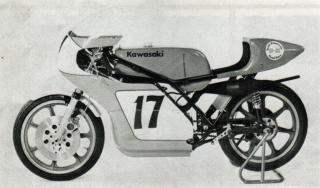
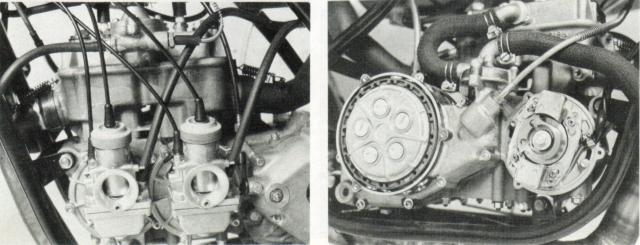
Q. What about the other racing bikes, the KR250 for example?
A. At the moment I'd say there is a 90 percent chance that we will contest the 250 class in Australia in 1976. Again, I would expect to have 250 class machines ready for the first round of the Australian 250.
Kawasaki's KR250, which Team Kawasaki hope to be campaigning in 1976. The bike has not fared well overseas, but with some development come come good. It is a watercooled, rotory disc valve, in-line twin.


Q. Nothing else? There was a rumor of a 350.
A. Yes, we had an S2 350 racer, which in fact is completed. We built it at our workshop and the thing now is that it's doubtful whether we will use it. We had intended to use it for the '76 season, but we haven't raced it yet, simply because if we decide to contest the 250 class it won't be possible, with the limited number of people we've got, to be able to run an additional class as well.
Q. Will the 350 go up for grabs?
A. Probably go up for grabs, I'd say at the moment. Also we'll probably sell at least two of our H2Rs to the public during the year as well. We've got four H2Rs at the moment, but I don't know who will get the two we sell - that's a matter to sort out, but we'll keep two H2Rs as back-up machines.
Q. In America Yamahas have definitely got the upper hand in road racing. Is that because of people like Kel Carruthers? Do you think if a Yamaha of that standard was racing in Australia that you'd have a harder time?
A. There's no question at all that Yamaha has the upper hand in America. There are two reasons: The first reason is Kel Carruthers and Ken Roberts. You don't have to beat Yamaha in America, you've got to beat Kel Carruthers and Ken Roberts for a start. At Ontario Roberts was so far ahead of everybody else it was a joke. Nobody can get anywhere near him on that type of circuit. Maybe on a shorter circuit, but on that type of circuit he was so far ahead it wasn't funny. I expected to see this anyway.
As far as the rest go, there doesn't seem to be any real problem, when you consider that Murray Sayle finished sixth overall - in front of two or three of the top Yamaha riders in America, and the same applies with Suzuki. The other thing that has to be remembered is that our setup in Australia is independent - in other words, while we have ties with the factory, we have a completely free hand in what we do. In America the Kawasaki racing setup was tied to the factory, in that the factory did the research and development work and sent the components to America. Now, this is probably one reason why we can do more development work. There isn't any doubt in my. mind and also in a lot of other people in the Kawasaki organizations - that our H2Rs are better than anywhere else in the world. I think that's been proven many, many times - the Yamaha people seem to think ours are the best.
Q. Will there be a lot more overseas racing from the Australian Kawasaki team in 1976?
A. This depends largely on the Kawasaki factory. Our first commitment is to the Australian distributors. This was basically the reason why this team was set up. Granted the team has developed differently from what was envisaged, but still the basic idea was to contest races in Australia for the good of Kawasaki distributors in Australia, so that has to be our prime consideration. Our arrangement with the factory is that we are to be on call to be used anywhere in the world they specifically want us to race. In addition to that, we can race anywhere we want to in the world - except we have to pay ourselves if we do that.
Q. That doesn't come out of the Australian funds?
A. We don't use any Australian funds outside Australia.
Q. So it's out of your own pockets and you hope for prize money?
A. That's right. Which is the same way any private team works. But in addition to that we can also be sent anywhere by Kawasaki, in which case they foot the bill. Now I would say that in 1976 we will probably do a few less races in Australia and more overseas, on the basis of discussions I have had with Kawasaki Heavy Industries. I've been asked to reduce the number of races that we do in Australia. I was asked to do that last year, but we didn't, because it seemed necessary to contest all the important races, and there were a few races we won over several rounds and so on. I really think we need a major re-think about the promotion of our race meetings in Australia: My personal feelings at the moment are, not only should we contest less races but I feel the promoters should run less races next year and make a bigger and better promotion of the races they do run.
Everywhere you go overseas they've found the same thing - a bigger and better promotion is a better thing and also it could mean an increase in prize money, which would make it easier for everybody concerned. So I intend, if I can find the time, to take up this with the various promoters and see if they can't do exactly what we're doing -reduce the number of meetings - then maybe we can contest all the meetings set down. I would like to see 12 or 14 major promotions, I believe that's sufficient and it would make my job a lot easier, I can assure you of that. Each of our bikes did 5000 racing miles last year. That's a lot, and it means the last three years for me have been seven days a week. I don't mind that, because I like motorcycle racing, but I think we could all do a better job including the promoters, if there was a more concentrated effort.
Hopefully that's what will happen in Australia. If it does, it will give us the chance to contest more races overseas, which would improve our performances, from the experience, and hopefully, what we take overseas may improve Kawasaki's chances over there. We'd like to think it would, anyway.
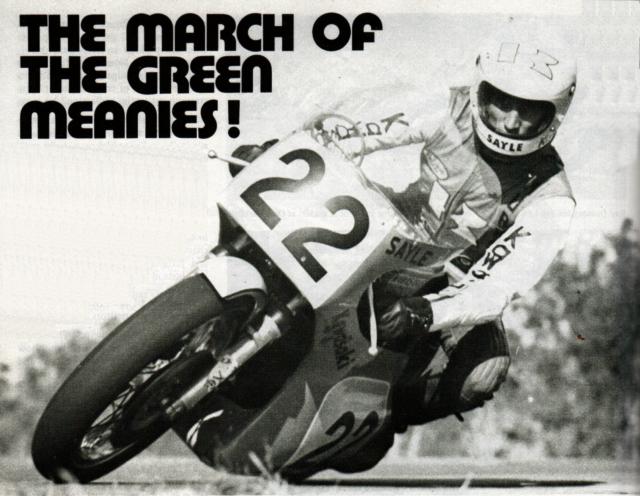
Q. You were talking about Kel Carruthers and Kenny Roberts. Would it be a bit of a personal thing to try and beat them? Is that something to aim for?
A. Not really. There is no doubt at all that Kenny Roberts is exceptionally good, but in addition to that he has the best prepared machine and of course that's a winning combination: If you've got the best machine and the best rider, you have to win. I don't for one minute think Kenny Roberts is unbeatable, but having some sort of an insight into what's happening in America, I can't see any combinations over there which are likely to be able to beat them.
Q. When the KR 750s are fully sorted, could you see Gregg or Murray giving Roberts a run for his money?
A. Yes quite definitely. I don't see that being beyond the realms of probability at all when you consider that the machine Gregg rode at Ontario was provided by the factory and was dismantled by us and re-assembled the way we normally do our engines. But we made no mechanical modifications to it.
Q. Was that on factory directive?
A. No, it wasn't, it was simply a case of playing it safe for one, and the second point was that we were invited to use those facilities and those machines -they weren't ours. I feel there could have been a very big political problem if we decided to walk in and take over and do things our way. We were there on invitation and we did it the way we were asked to do it - I wouldn't have done it any other way. We were told by the Japanese bosses over there that if we wanted to make any major modifications we could do so, but we were invited there by the American organization.
Another point was we didn't have time anyway. We had six days to build two machines from scratch to contest a race that everybody had been getting ready for five months, so we didn't really have much time. I can see a lot of things we could have done, but there wasn't time. So we did the best we could with what we had. What you have to remember is that Gregg finished third in his heat race. I think the placing was Roberts, Nixon, Hansford and I know our machine wasn't competitive with Roberts'. I think Gregg had done 25 laps of the circuit prior to his heat race on a machine he'd never seen before, so my opinion is that it was an excellent performance. On qualifying times - this isn't official but I believe it's correct -he was third fastest. He had a front row start, in grid position number five, front row, so he was in the fastest five, but I believe his time was in fact third fastest. So there isn't any doubt in my mind that as a team we could, with the right facilities, contest races in America and do equally as well as what Roberts will do. But make no mistake, they're good. The way I see it is if you beat Kenny Roberts in America you're going to win everything you go in, that's what it amounts to. So obviously, if you're going to race in America that has to be the objective. But I have no sort of particular wish to drop what we're doing here and go to America and beat Kenny Roberts - not at all.
Q. If it happens, it'll be part of the overall program?
A. Yes. I respect what they're doing over there and I believe Roberts and Carruthers are doing it the right way. Given the opportunity I feel we could be competitive with them, but it certainly isn't an ambition to do so. But if we were asked to do that specific job I believe we could do it, yes.
Q. Would you have been happier with the H2Rs in America, do you think?
A. Yes, no doubt we would have. We even visualized this before we went, so it isn't hindsight. We felt that what we had here would be more competitive than what a new undeveloped machine would be. Gregg passed that comment many times, that he would have far preferred to take his own machine. As it turns out he was surprised that the new machine was as good as it was, but he still realized it needed a lot of work to make it the way he wanted it.
Q. Why didn't you take your own machines?
A. Purely cost. It would have cost us $3000 to fly the two machines over and back and we didn't have $3000 - it was as simple as that. Our operation quite frankly is on a shoestring budget. It gets the job done but it's a tight budget. We get by and that's what counts. So, in all due respect I think we could have done better with H2Rs. Hansford's fastest time was only 1.6 seconds slower than Roberts' fastest time for the meeting, and I think we could have just about made up that 1.6 seconds. I also think Roberts could have gone faster if he was pushed, so that doesn't mean we would have been with Roberts, but what it does mean is we could have improved on our performance over there. But I was pretty happy with the performance. To get a front row start in world class racing and for Murray to finish sixth overall ... We were pretty satisfied with those results.
Q. Some people were a bit surprised when Murray was taken into the team, but he soon silenced his critics - if there were any. Do you think he's had a startling rise since he joined Team Kawasaki or do you think it's just that he's on a good machine, which let his skill shine?
A. Well, I think there are a lot of things involved. Firstly, when I decided we should have a second rider, my idea was to get a younger rider we could groom to gradually take over the position, because at that stage our intention was to only run one machine. In fact at that stage we only had one machine and only enough funds to just make that operate. I also had a job, which I used to do in addition to operating the team. When I say had a job, I owned a motorcycle business and I used to work in the business. I haven't for the last two and a half years because I haven't had time, I've been too busy.
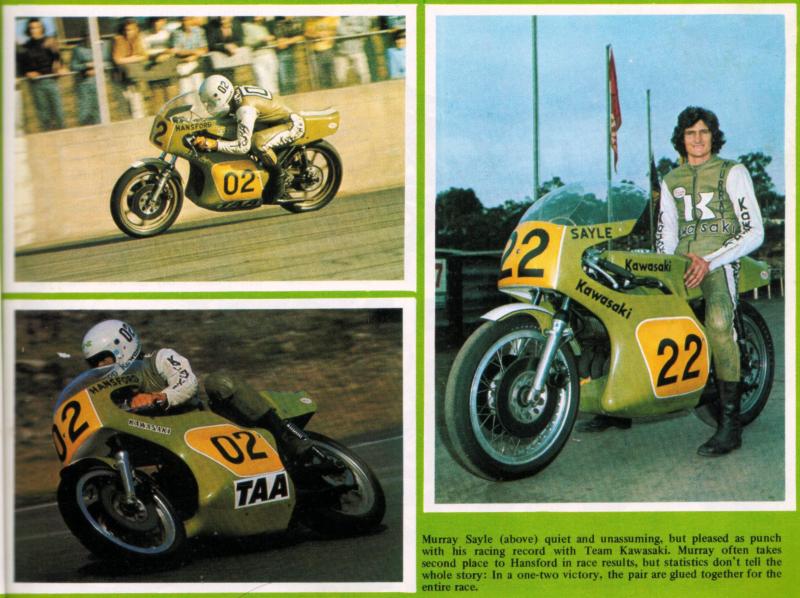
Q. Is it a Kawasaki dealership?
A. Yes. But now I have nothing to do with that business. I'm a chairman of directors of it, but I don't get involved in it at all simply because I'm never there. But, getting back to Murray, I had quite a look around and at that stage he was the most impressive rider - I could see he was going to do well, on many grounds. Firstly, he wasn't quite as fast as two or three of the older riders that were about, but he was purely a privateer and he would need help if he were going to go any further anyway. Secondly, he very seldom ever fell off -in fact I never saw him fall off up until that stage - and yet he was winning 350 class races, or at least placing well. So after a long look around, he was the fellow I picked. Initially he was told he would get maybe half a dozen rides in a year. He could continue to ride his Yamaha on the basis that we may eventually run two riders or he may eventually take over as being the one rider we were going to have.
Q. This was before Ron Toombs was hurt?
A. Yes. In February 1973 we started off with Ron Toombs and Ron rode the first season through until October '73, when he broke his leg in Western Australia. Then he had a break of four months where he didn't race at all -this was one of the reasons why we looked at putting on a second rider.
Ron rode a long time before he was actually fit - he started to ride again in January '74 and he wasn't really fit for about another three or four months after that. At that stage we had our new 1974 machine because our agreement with the factory was to get a new machine each year. So we decided to keep the old machine running and maybe, we thought, we would have enough parts and facilities to run it at half a dozen or so meetings per year -that was when we offered the extra ride to Murray. So that at that stage Ron Toombs was still our official rider and Murray was a back-up rider, and that's all he was. But after three or four rides in which he placed fairly well - seconds and thirds, not as fast as the top half a dozen guys, but he was still pretty good - our situation with parts and so on improved, so we decided to give him a contract to ride for twelve months. That contract was from June '74 to June '75 and during that period he contested most of the races as did Ron Toombs. Gregg Hansford had had quite a long association with us - although he was riding an opposition machine, we still traveled to meetings together and stayed at the same motels and so on and he was personally involved as far as we were concerned. But the riding relationship started in January 1975.
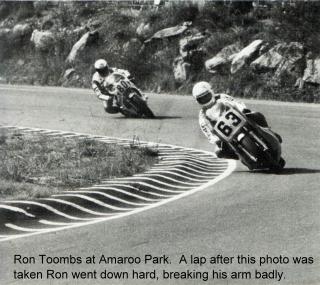
Q. Was that when it was apparent that Ron would be out of it for a while?
A. Not really. Ron was still riding at that stage and the idea was that Gregg wanted to join the Kawasaki team and our 1975 project had improved to the point where we had a third machine becoming available in February. Gregg to me, had the best potential in Australia, and he'd established himself very well. It was also obvious to me that maybe Ron would only be doing one more season so by the end of 1975 I was possibly going to need another rider anyway, so I decided I would have that rider at the start of 1975 and run three machines.
The first meeting we were to run three machines was Bathurst - the only meeting for the year, which was a disaster for us. There were many reasons why, but I guess probably Lady Luck has got something to do with it. Overall, Bathurst was the only meeting I was disappointed in for the year and there wasn't really anything I could have done about it, it was just one of those things. Gregg slid off in practice which may have been 50 percent his fault and 50 percent the fact that he hit a wet patch on the road. He may have been going a little bit faster than he should have been for five laps on a brand new machine -I don't know, but whatever, that's part of racing, and that put Gregg out of the running. Then Ron Toombs destroyed a gearbox in the first five laps of practice, so we had a big job then trying to fit all the leftover parts in, to try and get the machines competitive.
So we had to run Murray's bike with a five-speed gearbox, which costs four seconds a lap at Bathurst. This immediately put Murray at a disadvantage, so his fourth place at Bathurst was excellent when you consider he had about a four-second disadvantage. Ron Toombs was simply unfortunate; it rained hard on the Saturday: We had the machine set up, we had the new six-speed gearbox in it and it should have been perfect, but it got water in the magneto. We thought we had it fixed, but there was no way of telling because it rained so much Saturday and Saturday night. Sunday morning came out reasonably fine, the bike started up okay everything appeared to be right, but it went two laps reasonably well, then it went on two cylinders and that was it. We didn't have a new complete system to put on it. If we had, that may have fixed it. But he finished second in the first race, on two and sometimes three cylinders - it was unfortunate. In the other race, he had three pit stops to change plugs, simply because the magneto was playing up. There was just nothing we could do about it - it was a bit of a disappointment, but that's the way it went.
When I look back, it's only once in the year. We put in a performance, we got a fourth and a second, but not the performance that probably was expected of us. Certainly not the performance I was happy with. The thing I was happy with, and this is not known to many people, is that Gregg only did five laps of the circuit altogether on a brand new machine which had never been used or tested before - it hadn't even been started until we went to Bathurst as it was a machine we built in our workshop and said right, that's your machine for this weekend, away you go - and Gregg's fifth lap at practice was only 1.5 seconds outside the lap record. Warren Willing was credited with a new lap record officially, but I can send you to at least half a dozen people who did independent timings who will tell you that Ron Toombs did the fastest lap in the race and it was about a second faster than the existing lap record.
Q. There was a lot of controversy about that: The timing at Bathurst and the length of the track was in question, a difference of something like 0.4 kilometers, wasn't it?
A. Yes, that's right. But, this doesn't really concern me very greatly because lap records are not the answer - they're nice to have if you get them, but the thing is, I was just a little bit disappointed - Warren deserved his win, he was consistent on the day and so on - but by the same token if somebody could lap the circuit faster they should get the credit for being able to do so. We have fairly sophisticated timing equipment and we time every lap of all our riders so we know what's going on. In 1973 Ken Blake won the Six Hour race riding for us, and on the last lap we gave him the signal to say he was 31 seconds in front. Two weeks later the ACU finally decided he won by 31 seconds, which we told them on the last lap of the race. So I feel that most people accept that our timing equipment is fairly good and that our times are fairly right, so much so that a lot of opposition riders come over and ask us what their lap times are. But that's because we've got a couple of interested people who like doing it and they've got the proper equipment and they do a good job of it. So, at Bathurst we had three separate laps in the 23 second bracket, but the official time was slower than Warren's. As I said, I didn't complain about it, but I know Ron did do the fastest lap for the race. So we had that consolation - we could get around Bathurst as fast as anybody else, and with a bit of luck we would have got around as well as we do anywhere else. Gregg thinks his machine was the fastest bike at Bathurst and according to the revs it was pulling down the main straight and the gearing it was pulling, it certainly would have been the fastest. That seemed to be fairly obvious from watching the few laps at practice he did, and Ron's bike was just as fast in the race. He'd be in 10th place, he'd come in and change the plugs, then he'd go out and he'd get up to fourth place in about three laps. He'd just annihilate everybody, but then he'd go back on to two cylinders again. He came in once and he was only going on one cylinder. He'd done a whole lap on one cylinder - I don't even know how he got up the hill!
Q. What about Ron's future: Is he going to come back to the team?
A. It's a big question mark at the moment. I don't want to make any comment, or at least I don't want any comment to be printed relating to this that would cause any controversy. The position at the moment is very, very simple. Ron's contract expired in June and we've had no negotiations whatever about a renewal of that contract, for the simple reason that first, we would have to be convinced that he is fit to ride, secondly he would have to want to ride, and thirdly he would need the necessary doctor's clearance and so on that he was 100 percent fit to ride. Now we haven't got any of those three things at the present time. The situation with Ron is that his arm is improving all the time but it isn't 100 percent at the present time.
Q. So, it's just a matter of time to tell?
A. It's a question of looking. I think, at what his personal feelings are going to be at the time when he could in fact ride, but that time isn't here yet. At the moment he's not riding for us simply because he's unable to.
Q. What about your European debut, in France for the Moto Journal 200 last year?
A. We had all sorts of problems: Fuel, getting practice everything went wrong. When the bikes were weighed we had to have ours done twice. They weighed 134 kg in France - pretty close to the lower limit. In fact they were around 20 kg lighter than the nearest Formula 750 bike at the meeting. And when they counted the gears down the straight, they couldn't believe it: H2Rs from Australia with six-speed gearboxes! And they were the lightest bikes there too. The factory gave us one six-speed gearbox before Bathurst it was the only one made - and we made up another one of our own. As far as weight goes with the KR750s, they'll probably end up about 140 kg. As with the H2Rs, a lot of effort will be made to keep the weight low, because it's so tied in with ridability.
Q. With the team at the moment, is there a number one or number two rider?
A. When Murray signed his contract he became an independent Kawasaki rider. We don't have a number one or two -each rider races for himself. None of our riders have ever been told to slow down, though a couple of times they've been told to go faster! Sometimes I feel I should slow them down when they open up a big lead, but they're in it for themselves, and this formula has been successful, so why change it?
If we had machine breakage we might be more inclined to hang out the go-slow sign, but neither Murray nor Gregg are "crashers" - they both know exactly what they're doing. It's a hypothetical point, but if one or the other needed points for a series or something, and the other didn't, we still wouldn't give them instructions they'd probably work it out between themselves, but they wouldn't get orders from me.
The spoils of victory (the McCulloch Gold Cup, not Miss Molly Blue) from yet another one-two victory at Oran Park. Sayle and Hansford are certain to become international stars.
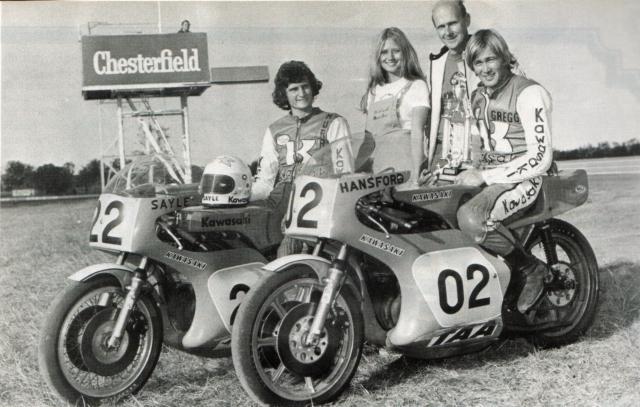
Q. What do you think, since the Kawasaki team started, has given you the most satisfaction one single incident or one single race meeting?
A. No, there isn't really any one point during the thing, which I could say, gave me a great deal more satisfaction than it does any other time. Racing is a funny thing and it probably does different things to different people. But the thing that has given me the greatest amount of satisfaction is the fact that the team has worked and has gained acceptance for what it is. It has taken a long time to get it to that stage. It's what I believed we could do when we first started and what a lot of top people told me could never happen in Australia; it would never work -- you wouldn't believe some of the across-the-table arguments I've had with the people that are associated with it.
I have a responsibility to operate the team and I said right from the outset that I'm going to do it my way, but when you have other people supplying the money and so on, it's often very difficult to get them to see it your way. I've been a bit pig-headed sometimes, but I've kept at it and people that I've upset along the way - when I say upset, I mean people have disagreed with me - I think the success has smoothed over the disagreements. When we go out to a meeting and do what we set out to do, I'm satisfied.
In retrospect, I think the day the Japanese said "We want you to work for us" was one of the high points.